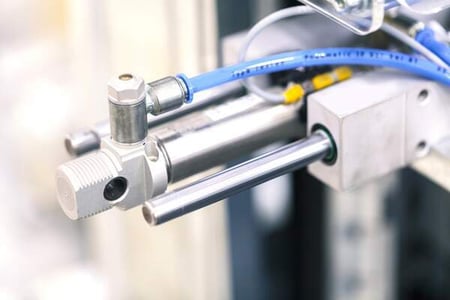 Let’s focus on Push to Connect fittings. They are available in different materials and are selected based on the application and tube material. These fittings are typically made of:
Let’s focus on Push to Connect fittings. They are available in different materials and are selected based on the application and tube material. These fittings are typically made of:
- Aluminum
- Brass
- Stainless steel
- Composite
- Nickel-plated Brass
- Plastic polymer
- Brass PEX (Cross-linked polyethylene)
They are easy to assemble by simply pushing the tube into the fitting where it seals. The most common styles are also easy to disassemble by pushing a collar on the fitting to retract the grip and allow the tube to easily slip out. Other styles are more permanent, where the tubing must be twisted out, often damaging the fitting.
Some manufacturers offer Push to Connect fittings along with Shut-off valves to be used with polyethylene tubing designed for use with a wide range of industrial water treatment applications, including:
- Water purification
- Vending & OCS
- Reverse osmosis
- Recreational vehicles
- Ice makers
- Marine
- Beverage dispensing
- Car washing systems
The fittings, valves and tubing used in these applications are typically required to meet FDA compliant materials and are listed with NSF International Standards 51 and 61. For applications requiring FDA compliance, these components are manufactured in white polypropylene with food grade EPDM O-rings.
Other Push to Connect fittings are intended to work with brass, PEX or CPVC tubing or pipe. PEX is a cross-linked, high-density polyethylene. CPVC is chlorinated polyvinyl chloride, a particular type of a thermoplastic. The fittings grip the tube/pipe with a series of metal spurs inside the fittings that tightly grip the OD when they are inserted into the fitting sockets. An O-ring (typically Neoprene) or other flexible material inside the fitting makes a tight radial seal on the outside diameter of the tubing to prevent leakage. The tubing is usually a high durometer material such as a high durometer polyurethane (i.e.95 shore A or higher), nylon, PEEK® or Teflon®. When these fittings are used with metallic tubing (i.e. brass), the tube OD may need to be grooved to accept the teeth of the fittings collet.
If you'd like to learn more about PTC standards, applications & specs, click here or below to download our latest whitepaper that includes comprehensive information about PTC Fittings!
Sources:
- Hydraulics & Pneumatics
- Beswick Engineering
- Bendix Commercial Vehicles Systems, LLC
- Brennan, Inc.: Versa Fittings
- S. Department of Transportation: Federal Motor Carrier Safety Administration
- Yukon Department of Highways and Public Works
- The Spruce: All About Push-Fit Plumbing Fittings

